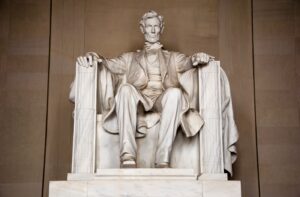Last month, NYU School of Law hosted a symposium titled “Making Constitutional Change: The Past, Present, and Future Role of Perry v. Brown.” Originally designated Perry v. Schwarzenegger, this is the case in which district judge Vaughn Walker declared California’s Proposition 8 unconstitutional, a decision later affirmed by the Ninth Circuit. It is also the case that proponents of legally redefining marriage hope will secure same-sex couples a federal right to marry, if and when the US Supreme Court grants it certiorari in the not-too-distant future.
The line-up for the NYU Perry symposium featured a veritable who’s who of the so-called “gay rights movement,” including Rachel Maddow, the popular MSNBC host and the first Rhodes Scholar to identify as lesbian; Kenji Yoshino, NYU Law’s distinguished constitutional law professor, and author of the movement’s most celebrated response to the now famous essay “What Is Marriage?”; Evan Wolfson, founder and president of Freedom to Marry, one of the foremost NGOs pushing the legal redefinition of marriage; Jon W. Davidson, legal director of Lambda Legal, the nation’s oldest and largest LGBT rights organization; and Matthew Coles, the director of the ACLU Center for Equality.
Those speakers had plenty to say on the subject of Perry v. Brown, and they had a very sympathetic audience to say it to. But the feature event of the day was an hour-long conversation with the plaintiffs’ litigators for Perry, Ted Olson and David Boies.
For many of us, hearing the names Olson and Boies takes us straight back to the year 2000, when these two attorneys faced off on opposite sides of Bush v. Gore, the Supreme Court case that resolved the complex disputes over the uncertain outcome of the 2000 election.
Start your day with Public Discourse
Sign up and get our daily essays sent straight to your inbox.George W. Bush’s litigator Ted Olson, who emerged successfully in the case, is a self-avowed conservative. He recently even helped Congressman Paul Ryan prepare for the vice presidential debate, standing in as Vice President Joe Biden for their numerous practice sessions around the country.
But despite his generally conservative leanings, Ted Olson staunchly supports legally redefining marriage to include same-sex relationships. So when David Boies, the man who played Dr. Moriarty to Olson’s Sherlock Holmes in Bush v. Gore, called him up for help on the Perry case, he agreed on the spot.
Now these two famed litigators—the “superlawyers,” as Yoshino referred to them, reassuring law students that super-status is as attainable in law as in modeling—have joined forces to fight for the legal redefinition of marriage. Uniting from across the aisle with one another, they hope to unify our nation on this controversial issue, which they believe is bigger than our partisan divide. On this point, at least, the dynamic duo is certainly correct: Marriage is far bigger than partisanship.
As I sat through their keynote interview, I was struck by two things. First, these two men are incredibly kind-hearted. They are fighting this battle because they believe they have a moral imperative to do so—to defend those who they believe are being unjustly deprived of their rights.
Second, despite their very laudable subjective motives, Olson and Boies have completely overlooked the central question in this debate: What is marriage? Since they haven’t asked or tried to answer this pivotal question about the reality of marriage, but have instead based their arguments purely on political terms of equality and fairness, they have mischaracterized the entire dispute as a battle of discriminators against the discriminated. Misunderstanding the debate’s true point of contention has led them unintentionally but fatally to beg the question in all of their arguments.
Olson and Boies—and the movement in general—claim that preserving marriage as a union of man and woman is unjust discrimination. For no good reason, they assert, the “right to marry” is being denied to same-sex couples, who are just as capable of loving and committing to each other as opposite-sex couples are. Boies summarized the basic thrust of their position fairly well, saying, “The key thing is that we are all alike in the way that matters: love.”
Their framing the issue in terms of discrimination makes some sense of their constant references to miscegenation as an alleged analogue. Olson and Boies view so-called “gay marriage” as the civil rights issue of our time, because they believe that same-sex couples are being treated as an inferior class of persons by the bigoted majority of our nation’s citizens.
On Marriage and Grammar
But beneath all of that rhetoric, the arguments undergirding their discrimination claims rest on faulty reasoning. And to get at where they have gone awry, we need a quick refresher course in first grade grammar. Specifically, we need to recall the crucial distinction between “Can I?” and “May I?”
By way of illustration, think back to the embarrassing and obnoxious response your teacher used to give when a student would ask, “Can I go to the bathroom?” “I don’t know,” she would say, “Can you?” The child’s mistake lay in confusing “Can I?”—an interrogative dealing with possibility—with “May I?”—which pertains rather to permissibility. Instead of asking whether he was allowed to go to the bathroom, the confused pupil accidentally asked if he was capable of that feat at all. Yet childhood errors have a way of coming back to haunt us, and that is precisely what has happened in the debate over redefining marriage.
Olson, Boies, and their allies have systematically confused a debate about metaphysical possibility with one about political permissibility. They are arguing that our government ought to let same-sex couples marry, and they are convinced that their opponents are arguing over the same point, just on the other side of the issue.
But that is a gross mischaracterization of the disagreement. For our position is not that the government should refuse to let such couples marry, but rather that the government is utterly impotent with regard to this question. Our response to same-sex couples desirous of marriage is not “You may not,” but rather, “You cannot.” We do not seek to bar anyone from marriage; we just believe marriage is a union that is necessarily and by its very nature heterosexual. Maybe we are right, or maybe Olson and Boies are. But regardless, the question to be settled in this debate is not whether to bring a latent potency into actuality, but whether there is in fact any potency present in the first place.
Framing the issue as a “May I?” dispute allows the superlawyers their stirring rhetoric about prejudice and civil rights. But, more perniciously, this mischaracterization also allows them to conceal the circularity of their argument for those discrimination claims.
Boies and Olson’s underlying judgment is that, because same-sex couples could get married if only the government would let them, marriage is therefore not necessarily a heterosexual institution. And at that point, the pair understandably concludes that there remains no principled reason to oppose the legal redefinition of marriage, since they have established that sexual difference has no bearing on the nature of marriage at all. In Yoshino’s words, they think that, shorn of any principled objections, the adversaries to their policy must be motivated merely by “pride, prejudice, and fear.”
But their argument presumes exactly what it was meant to prove. If you begin by saying that it is within the government’s power to extend marriage to same-sex couples, then of course sexual difference is not an essential feature of marriage. If you frame this as a “May I?” disagreement, then you necessarily treat the “Can I?” question as already settled. But that line of thinking fatally begs the question, because the “Can I?” question is not settled at all.
For if those of us who oppose the legal enshrinement of so-called “same-sex marriage” are correct, then the government can no more make same-sex couples married than it can make pi equal to three. In other words, no judicial or legislative fiat can make two men married if marriage is by its very nature heterosexual. And since that is the true point of contention in this debate, presuming that the government has the power to extend marriage to same-sex couples cannot serve as the starting point for discussion.
Granted, in the most generic sense, distinguishing between opposite-sex and same-sex couples is indeed a discriminating act. But in that broadest sense, all distinctions are discriminating, and no party to this debate is so foolish as to believe that we should abolish all distinction-making.
So the key question, then, is whether or not this is the right distinction to make. As regards marriage, is this discrimination between opposite-sex and same-sex couples justified? And to answer that we have to turn to the question underlying this entire issue: What is marriage?
My point here is not to settle this question of the nature of marriage, but to draw attention to the truth that it is precisely this question which must be answered if we are to settle the larger debate over same-sex couples and marriage. Those convinced and willing to investigate that crucial question would do well to begin with reading the seminal “What Is Marriage?” essay, and the revamped, expanded, and vastly enhanced forthcoming book into which the essay has evolved.
Also of interest is R.J. Snell’s criticism of Yoshino’s response to that essay, which draws attention to Yoshino’s refusal to ask the relevant questions. Stephen J. Heaney has a wonderful thought experiment for discerning the nature and purpose of marriage, which is well complemented by Dr. Jennifer Roback Morse’s reflections on marriage, the state, and children. Finally, here are three wonderful pieces that unpack the superlawyers’ attempts to analogize sex to race in the marriage debate. (All of these articles, by the way, are published in Public Discourse.)
On Marriage and Legal Strategy
The NYU symposium provided Olson and Boies with an audience that was very amenable to their views. As such, the pair felt very comfortable sharing openly, even going so far as to unveil their strategy for litigating Perry at the Supreme Court level. Ideally, if improbably, they want this to be a unanimous decision, an undivided court securing the controversial “right to marry” for all couples regardless of sex. And to get even someone as unlikely as Justice Scalia on board, they plan to appeal to the judge’s well-known positivist tendencies, essentially asking him to foreswear the natural law and his “personal views” of morality. Specifically, they want him to follow his dissent in Lawrence v. Texas, wherein he laments that by overturning the sodomy laws, the court has effectively decided the marriage question as well. You’re exactly right, they will tell him, and now that Lawrence is the well-established law of the land, put aside your “personal views,” as you have said judges must, and follow this case through to its obvious conclusion.
Regarding Justice Scalia’s vote, I will not be holding my breath. But Olson and Boies’ Supreme Court strategy does reinforce one crucial point: as long as we keep philosophy off the table, the traditional understanding of marriage is doomed. If we fail to ask about the nature of marriage, and fail to demand that our interlocutors do the same, then we will have no one to blame but ourselves when marriage as the union of man and woman is erased from the books.
Therefore, to defend this foundational human institution, we must take refuge in the nature of marriage, insisting that all questions of political permissibility wait until the contentious question of metaphysical possibility has been settled. For if Aquinas was correct—as indeed he was—that a “law” at odds with justice is no law at all, then how much less so would be one at odds with reality itself?












